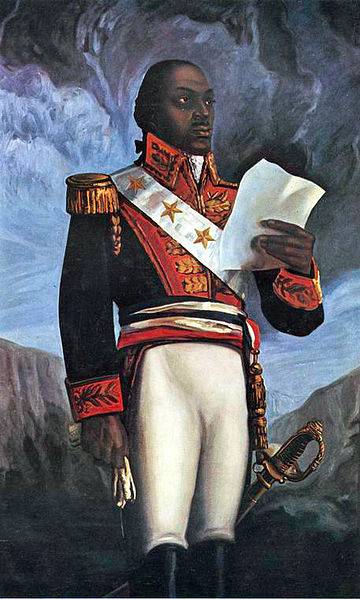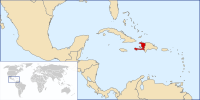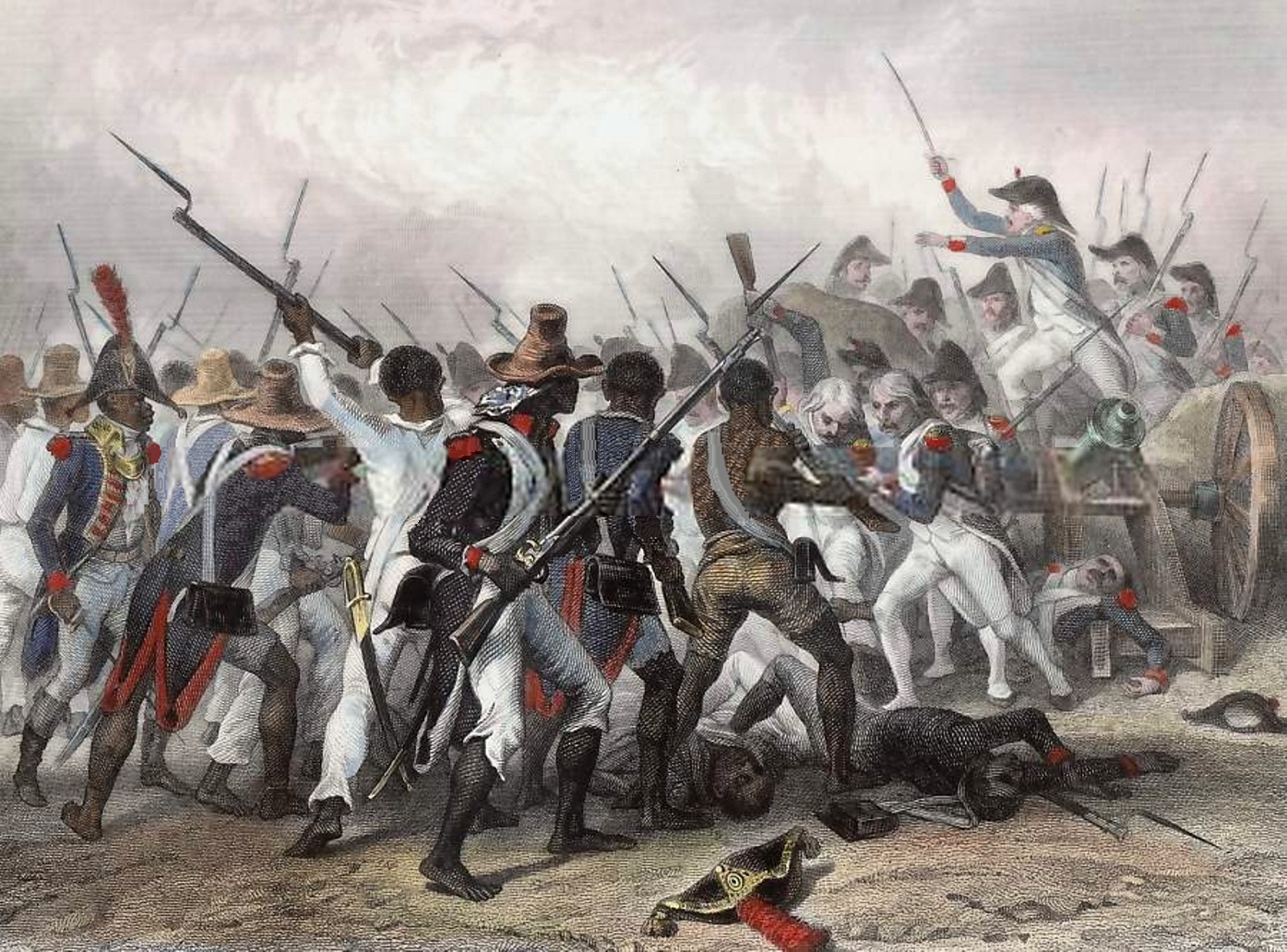Portrait of Toussaint L'Ouverture

Topics on the page
A. Overview of Toussaint L'Ouverture and Haitian Revolution
B. Relationship to the American and French Revolutions
C. Haitian Declaration of Independence
- Teaching and Learning Resources for Haiti and Slavery in Latin America
D. American Occupation, 1915-1934
- Charlemagne Péralte and Haitian Resistance to the U.S. Occupation
 Haiti and the Atlantic World, Julia Gaffield, Georgia State University has founding documents for Haiti and its connections to the broader Atlantic World.
Haiti and the Atlantic World, Julia Gaffield, Georgia State University has founding documents for Haiti and its connections to the broader Atlantic World.
 Teaching the Haitian Revolution, Jennifer Pontius-Vandenberg, Social Education (November/December 2020)
Teaching the Haitian Revolution, Jennifer Pontius-Vandenberg, Social Education (November/December 2020)
A. Overview
Also known as: The Black Napoleon, Napoléon Noir, Black Spartacus

 Primary Sources
Primary Sources
Toussaint L'Ouverture Letter to the French Directory (1797)
Toussaint L'Ouverture Biography/Autobiography (1853). John Relly Beard, republished in 1863 to include L'ouverture's 35 page autobiography
The Haitian Revolution Timeline
- In 1791, slaves united to revolt against the slave-labor plantation system in Saint-Domingue, the French half of the island of Hispaniola
- L'Ouverture, a former slave whom historians believe was well educated, was instrumental in both negotiating with French leadership and organizing Black citizens of Saint-Domingue.
- England and Spain were heavily involved after declaring war against France, and Haiti became the stage for a bigger imperial battle. England intended to take Haiti as its own colony and re-institute slavery. The revolutionaries initially allied with Spain, but they had a tense relationship because L'Overture and other officers believed they were not doing enough to abolish slavery. Spain eventually ceded their half of Hispaniola, Santo Domingo (Dominican Republic), to France.
- After the French Revolutionary government abolished slavery in 1794, L'Overture re-allied with the French and became brigadier general of a poly-racial army. In 1897, L'Ouverture became governor for life of Saint Domingue.
- In 1802, after gaining control of France, Napoleon Bonaparte attempted to regain control of and to restore slavery to the colony. Napoleon's troops captured L'Ouverture who died in prison in 1803.
- Revolutionary leaders Jean-Jacques Dessalines and Henri Christophe continued the fight for independence, and France surrendered at the end of 1803.
- On January 1st, 1804, Saint-Domingue became Haiti, the second independent nation in the western hemisphere (the first in Latin America) and the first free Black-led republic in the world.
B. Relationship to the American and French Revolutions
- The United States and Haiti at the time of their revolutions were connected by trade, their militaries, and ideology.
- Haiti was a key trading partner for the American colonies because they were nearby, provided many raw goods, and were mostly unaffected by the trade restrictions set by England and France.
- Nearly one thousand freed slaves from Haiti joined French troops to help fight in the American Revolution, participating in key battles at Savannah, the Capes.
- This was, in part, to show their loyalty to France as things grew more hostile in Saint-Domingue. Some key figures of the Haitian Revolution fought in these battles, and it is likely that they exchanged important revolutionary ideas.
- Saint-Domingue looked to the United States as an example of a colony defeating its imperial rulers. The ideas of liberty and citizenship were promoted in similar ways, but taken to much greater levels in Haiti, as all slaves were liberated and granted political rights far before they were in the United States.
- After the revolutions, US President John Adams kept a positive relationship with Haiti, but his successor, Thomas Jefferson, severed ties with the country. Despite plenty of informal trading, the United States and Haiti would not have a diplomatic relationship until after the Civil War and Emancipation Proclamation. Even then, US Congressmen refused to meet with their black counterparts from Haiti. (See here for an examination into efforts by the George Washington administration to undermine the new Haitian Government)
- Just like with the United States, Haiti's revolution had a two-way relationship with the one in France. While they were inspired by the same circulation of revolutionary ideas across the Atlantic, pressure from Haiti - and concern that they would lose the colony - forced French revolutionaries to abolish slavery at home and in their colonies before other European powers.
 Primary Sources
Primary Sources
Jefferson on the French and Haitian Revolutions, 1792
C. Haitian Declaration of Independence
Original illustration by Auguste Raffet, 1839

 Primary Sources
Primary Sources
Haitian Declaration of Independence (1804)
Haitian Constitution of 1801
Haitian Constitution of 1805
- These two constitutions offer a fascinating instance of a country adopting a radical constitution and then replacing it with a considerably more radical one within the span of four years.
 Teaching and Learning Resources for Haiti and Slavery in Latin America
Teaching and Learning Resources for Haiti and Slavery in Latin America
Teaching About Haiti in World History, by Alyssa Goldstein Sepinwall, explains how Haiti has been left out of world history classrooms, why this needs to change, and how to incorporate it into lessons.
"A Short and Oversimplified History of Haiti" by Bob Corbett of Webster University
The Haitian Revolution from Kreyol.com, a private site dedicated to Haitian history and culture
Douglas Egerton on the Haitian Revolution, Toussaint L'Overture and Jefferson from PBS
For more information on the history of Haitian Women's Involvement
Info on Sanité Bélair, with excerpts from C.L.R. James' The Black Jacobins, can be found here.
A video with more info on Bélair here
Slavery in Latin America
Episode 11: The Haitian Revolution from 15 Minute History, University of Texas
Toussaint L'Ouverture: A play by C.L.R. James
 The Haitian Revolution from the Choices Program, Brown University
The Haitian Revolution from the Choices Program, Brown University
Haitian Revolution Lesson Plan from Middle Tennessee State University
More Primary Sources and Lesson Plans here
Timeline of Haitian history, from Brown University
Quizlet Flashcards
Teaching about Haiti has many teaching resources including films, books, lesson plans, media investigations, and primary source poems and songs.
D. American Occupation, 1915-1934
Preceding WWI Haiti was considered a very unstable country by American policymakers.
- For 70 years preceding WWI Haiti had had 102 revolts, wars, and/or coups. Only one of the country's presidents had ever made it through their whole term alive. When WWI began in Europe the current leader was dragged out of a building by a mod and killed.
- This unstableness worried President Woodrow Wilson. The U.S. had not yet joined the war but was nervous with Germany's imperialistic moves as it continued to expand across the European continent.
- In 1915, Defoe the U.S. joined war in Europe, the U.S. "took over" Haiti and controlled it for the next 19 years.
- See here what military occupation looked like and some pictures of the harsh reality.
U.S. Invasion and Occupation of Haiti, 1915-1934
Intervention in Haiti from Digital History
History of U.S. Interventions in Latin America
Charlemagne Péralte and Haitian Resistance to the U.S. Occupation

Charlemagne Prelate led resistance to American occupation
Bandits or Patriots? Documents from Charlemagne Peralte
Death of Charlemagne Péralte, 1919
Sources
- Dubois, Laurent. Avengers of the New World: The Story of the Haitian Revolution. Cambridge, MA: Belknap Press of Harvard University Press, 2004.
- Dubois, Laurent. “Two Revolutions in the Atlantic World: Connections between the American Revolution and the Haitian Revolution.” History Now 34. 2012. Accessed April 11, 2016. https://www.gilderlehrman.org/history-by-era/global-history-and-us-foreign-policy/essays/two-revolutions-atlantic-world-connection.
- Ghachem, Malick W. “The Antislavery Script: Haiti’s Place in the Narrative of Atlantic Revolution.” In Scripting Revolution : A Historical Approach to the Comparative Study of Revolutions, edited by Keith Baker and Dan Edelstein. Stanford, CA: Stanford University Press, 2015.
- Girard, Philippe R. “Haiti and the Early United States,” American History: Oxford Research Encyclopedias. 2015. Accessed April 29, 2016. http://americanhistory.oxfordre.com/view/10.1093/acrefore/9780199329175.001.0001/acrefore-9780199329175-e-256.
- Goldstein Sepinwall, Alyssa. "Teaching about Haiti in World History: An Introduction.” World History Connected. 2013. Accessed May 4, 2016. http://worldhistoryconnected.press.illinois.edu/10.2/sepinwall.html.
Comments (0)
You don't have permission to comment on this page.